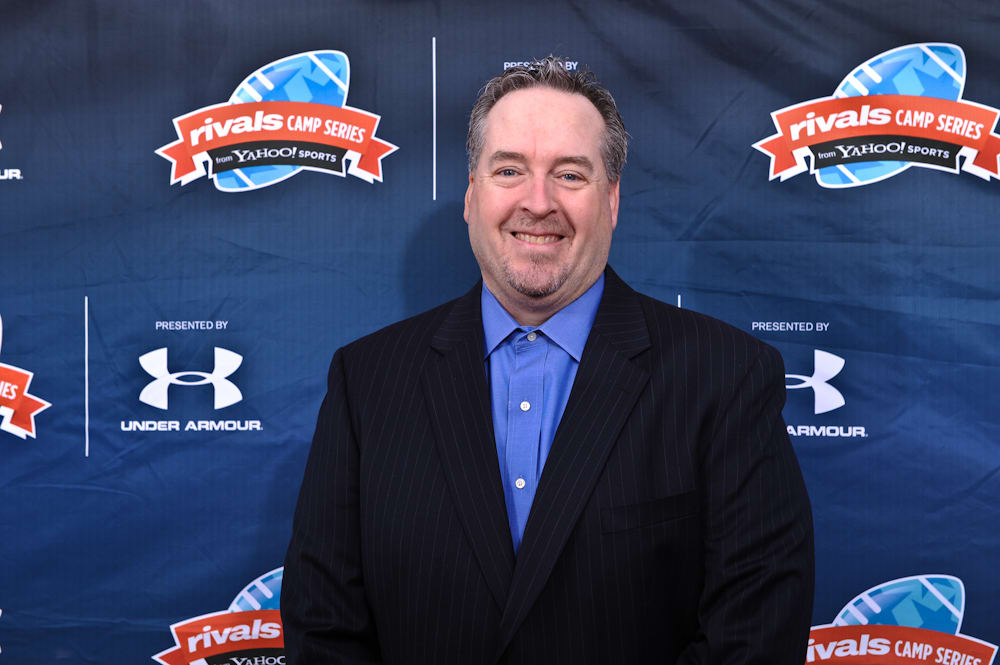Mark Pszonak contributed to this report.
Junior college recruiting is always hit or miss and some programs do it well while others refrain altogether. Here are the teams that have recruited the most four- and five-stars since 2010 with mixed results.
MORE: The 10 best recruiting programs in the past five cycles
CLASS OF 2021 RANKINGS: Rivals 250 released | Rivals100 revealed | New five-stars | Mind of Mike | Ranking top QBs

*****
TENNESSEE: 19 PLAYERS
The players: Savion Williams (2019), Jordan Allen (2018), Dominick Anderson (2018), Emmit Gooden (2018), Jonathan Kongbo (2016), Jeff George (2016), Alexis Johnson (2016), Alvin Kamara (2015), Justin Martin (2015), Chris Weatherd (2014), Dontavius Blair (2014), Lavon Pearson (2014), Cordarrelle Patterson (2012), Daniel McCullers (2012), Byron Moore (2011), Izauea Lanier (2011), Maurice Couch (2011), John Brown (2010), Dave Clark (2010)
The skinny: The Vols have clearly brought in the most top-level JUCO talent over the last decade, but the production from these players has been somewhat sporadic. Most known from the group is Kamara, but that is more for his current success in the NFL than for his time in Knoxville. Patterson had some dynamic moments during his one season with the Vols, while players like Couch, Moore, Lanier, Johnson and McCullers supplied much-needed depth at positions. Gooden and Anderson had promising 2018 seasons,
Farrell’s take: There are some big names on this list, huh? I am surprised that some guys like Kongbo never made a big splash (or haven’t yet) with the ability they have, but it’s not surprising to see players like Kamara and Patterson have success in college and even more in the NFL. Patterson was under consideration for a fifth star back in the day as it was a heavy debate, and Kamara was a no-brainer. I can say more was expected overall of this group.
*****
ALABAMA: 11 PLAYERS
The players: Saivion Smith (2018), Elliot Baker (2017), Isaiah Buggs (2017), Charles Baldwin (2016), D.J. Pettway (2014), Dominick Jackson (2014), Travell Dixon (2012), Jesse Williams (2011), Aaron Douglas (2011), Quinton Dial (2011), Dequan Menzie (2010)
The skinny: The Tide have obviously dominated recruiting over the last decade, but their success with JUCOs has been far from positive. Three five-stars have been brought in during recent years, with only Buggs making a sizeable impact during the 2018 season, while offensive linemen Baldwin and Baker were both dismissed from the program. However, Smith had a very good year at Alabama.
Farrell’s take: I’m a little surprised Alabama has relied so much on JUCOs, although 11 isn’t a huge number when talking about 2010 to 2019. The Tide have had some very high-profile names and many just haven’t lived up to the hype, but that’s not surprising as Nick Saban doesn’t stand for foolishness. JUCOs come with added risk and players like Baldwin and Baker are great examples of that.
*****
AUBURN: 11 PLAYERS
The players: Jovon Robinson (2015), Jason Smith (2015), D’haquille Williams (2014), Davonte Lambert (2014), Derrick Moncrief (2014), Ben Bradley (2013), Cameron Artis-Payne (2013), Cameron Newton (2010), Brandon Mosley (2010), Joel Bonomolo (2010), Roszell Gayden (2010)
The skinny: Along with Alabama, Auburn is the only other program to bring in three five-star JUCOs since 2010. However, there is no reason to look any further on the Tigers’ list than Newton, whose performance will never be forgotten at Auburn. The other two five-stars at Auburn did not bode as well, with both Robinson and Williams being dismissed from the university. Other bright spots came from Artis-Payne, who rushed for 1,608 yards and 13 touchdowns in 2014, and offensive lineman Mosley, who was a two-year starter at right tackle.
Farrell’s take: Newton won Auburn a national title, so it doesn’t matter what everyone else on this list did, right? He was the best JUCO prospect I’ve ever seen over all my years at Rivals.com and his impact on college football was not surprising. Williams would have done well had he been able to keep his head on straight, and I really liked Robinson as well, but again these are the risks associated with JUCOs. Overall Auburn has had a good experience with JUCO prospects.
*****
OLE MISS: 11 PLAYERS
The players: Lakia Henry (2019), Samuel Williams (2019), Noah Jefferson (2018), D.J. Jones (2015), Tony Bridges (2015), Tee Shepard (2014), Lavon Hooks (2013), Nickolas Brassell (2013), Randall Mackey (2010), Damien Jackson (2010), Wayne Dorsey (2010)
The skinny: Star power has been lacking from the Rebels’ top-level JUCO additions to this point, but they have added several key contributors over the last decade. Defensive backs Bridges and Jackson both became important members of their respective teams, while defensive linemen Jones, Hooks and Dorsey all added much-needed depth. Everyone’s eyes now turn to Henry and Williams, who will both be expected to contribute immediately in 2019.
Farrell’s take: There aren’t huge names on this list, but there are guys who have made key contributions. Brassell was probably the one I thought would have the best career but again things happen and talent is often squandered. Williams and Henry will have a good impact right away however.
*****
GEORGIA: 10 PLAYERS
The players: DJ Daniel (2019), Jermaine Johnson (2019), Devonte Wyatt (2018), D’Marcus Hayes (2017), Javon Wims (2016), Shattle Fenteng (2014), Toby Johnson (2013), Jonathon Rumph (2013), Johnathan Jenkins (2011), Jakar Hamilton (2010)
The skinny: With the arrival of Daniel and Jermaine Johnson on campus, the Bulldogs hope to improve their recent JUCO luck. While several of their additions have contributed, none have made the impact that many expected. Wims had a nice 2017 season with 45 receptions for 720 yards and seven touchdowns, Toby Johnson added important depth to the defensive line in 2014, Jenkins showed flashes of stardom in both 2011 and 2012 on the defensive line and Hamilton did the same in the secondary in 2010.
Farrell’s take: Remember any of these names? Not many had a big impact, which is a bit surprising, but it’s clear Kirby Smart is more willing to go the JUCO route than Mark Richt, was so with that might come more success. Daniel and Johnson certainly have a lot of talent to offer.
*****
UTAH: 10 PLAYERS
The players: Bamidele Olaseni (2019), Corrion Ballard (2017), Garett Bolles (2016), Troy Williams (2016), Cory Butler (2015), Andre Lewis (2013), Visesio Salt (2012), Kelvin York (2012), Keith McGill (2011), John Cullen (2010)
The skinny: The Utes have experienced some success with their JUCO targets over the last decade. Most notably was Bolles, who was an All-Pac 12 offensive lineman selection in 2016 and was then selected by Denver in the first round of the 2017 NFL Draft. While other players like Ballard, York and McGill didn’t experience the same level of success as Bolles, they all became key contributors for the Utes during their time in Salt Lake City.
Farrell’s take: Utah is a bit of a surprise on this list. Bolles is the big name here, but most of the players it has landed have made an impact, so Olaseni will likely pan out as well. Utah does a good job selecting its JUCOs and coaching them up.
*****
ARIZONA STATE: 9 PLAYERS
The players: Dougladson Subtyl (2016), Christian Hill (2016), Davon Durant (2015), Eric Lauderdale (2014), Dalvon Stuckey (2014), Marcus Hardison (2013), Marion Grice (2012), George Bell (2010), Brice Schwab (2010)
The skinny: The Sun Devils have added nine top-level JUCOs since 2010, but only two have made significant contributions on the filed. Hardison established himself as an elite playmaker during his second season on the defensive line, finishing with 53 tackles, 15 tackles for loss and 10 sacks, while Grice became a leader on the offensive side of the ball during his two seasons, finishing with 1,675 yards on the ground, 863 yards receiving and 39 total touchdowns.
Farrell’s take: The big name missing here is Damarious Randall, who was a low three-star JUCO in 2013 who turned out to be a first-round NFL pick. Hardison and Grice were both highly touted JUCO prospects and panned out well, but Arizona State has shied away from the big-name JUCO pool in recent years. That doesn’t mean they don’t recruit them, they just haven’t had as much success.
*****
NEBRASKA: 9 PLAYERS
The players: Dedrick Mills (2019), Greg Bell (2018), Randy Gregory (2013), Zaire Anderson (2012), Mohammed Seisay (2012), Daimion Stafford (2011), Lavonte David (2010), Jermarcus Hardrick (2010), Chase Harper (2010)
The skinny: The Huskers have had their fair share of JUCO disappointments over the last decade, most recently Bell’s decision to transfer to San Diego State after only four games last season, but David’s two-year career will be one fans will remember for a long time. Totaling 285 tackles, 24.5 tackles for loss and 11.5 sacks during his time in Lincoln, he has continued his impressive level of play in the NFL. And while his NFL career has been marred by turmoil, Gregory’s time with the Huskers was also extremely productive.
Farrell’s take: It’s hard to find two bigger names than David and Gregory on this overall list, and both were exceptional talents. Bell had a ton of talent and I thought he was going to be a star and I think Mills can be a good one as well, as Scott Frost isn’t afraid to dive into the JUCO world.
*****
MISSISSIPPI STATE: 8 PLAYERS
The players: Fred Peters (2019), Kareem Walker (2019), Chauncey Rivers (2017), Deion Pope (2017), Martinas Rankin (2015), Donald Gray (2015), Denico Autry (2012), James Carmon (2010)
The skinny: Optimism is high in Starkville that both Peters and Walker can make an immediate contribution in 2019, but as for previous JUCO signees, there have been several key contributors. Many expect Rivers to have a breakout season this fall, Rankin anchored the Bulldogs’ offensive line for his two seasons, Grey was a reliable threat at wide receiver and Autry was a playmaker at defensive tackle.
Farrell’s take: Mississippi State has gone the high-level JUCO route less than expected, especially with all the talent in state, but Montez Sweat isn’t on this list as he was a three-star and he developed into a freak. The same will likely happen with Rivers and both Peters and Walker have great potential.
*****
LSU: 6 PLAYERS
The players: Badara Traore (2018), Travez Moore (2018), Jeremy Cutrer (2015), Jevonte Domond (2014), Quantavius Leslie, (2013), Zach Mettenberger (2011)
The skinny: While there is still hope that Traore can make an impact on the offensive line this season, the Tigers have to go back to Mettenberger to find a high-profile JUCO signee who didn’t disappoint. He led LSU to a 19-6 record, passed for almost 5,700 yards and threw 35 touchdown passes during his two seasons as a starter, both of which he was a team captain.
Farrell’s take: Highly ranked JUCOs haven’t worked out that well for LSU over the years, aside from Mettenberger, but the Tigers don’t rely on them often. There is so much talent in state they don’t have to reach to the JUCO ranks that much.
*****
FLORIDA STATE: 5 PLAYERS
The players: Chad Mavety (2014), Cornellius Carradine (2011), Jacob Fahrenkrug (2011), Mike Harris (2010), Glen Stanley (2010)
The skinny: It has been a mixed bag of results for the Seminoles. Successes have come from players like Carradine, with 118 tackles, 21 tackles for loss and 16.5 sacks, and Harris, with 99 tackles and five interceptions, who both had extremely productive careers in Tallahassee.
Farrell’s take: The Seminoles don't go the high-level JUCO route often, but when they do they’ve shown it can work out.
